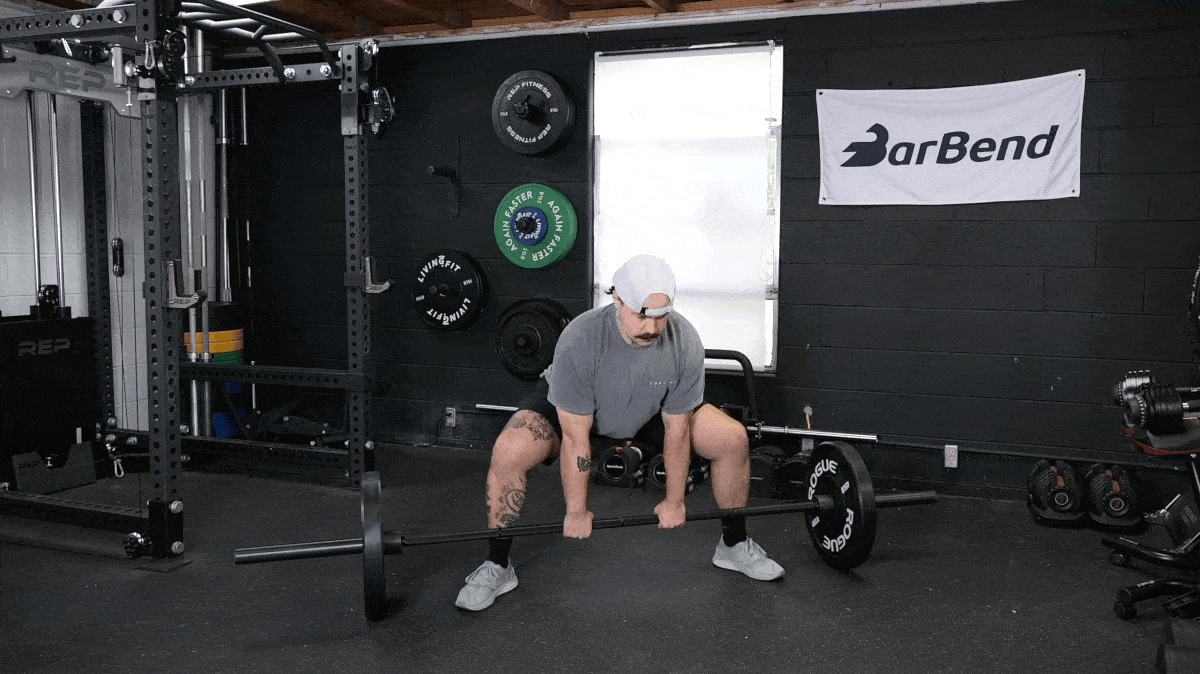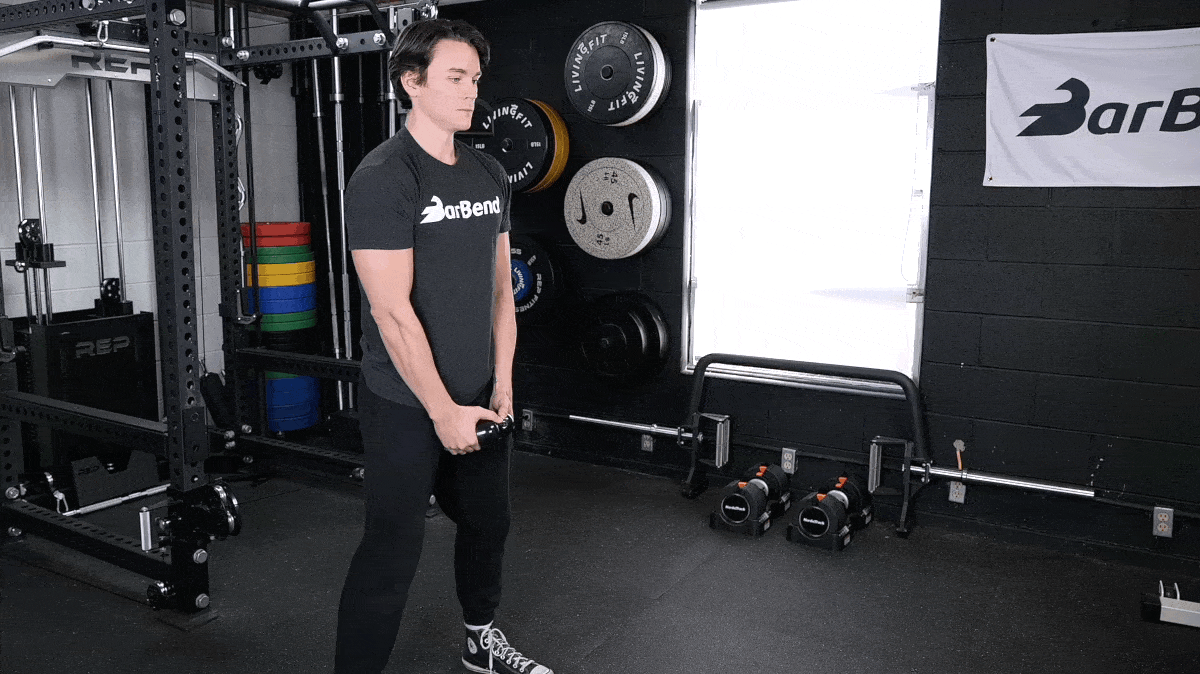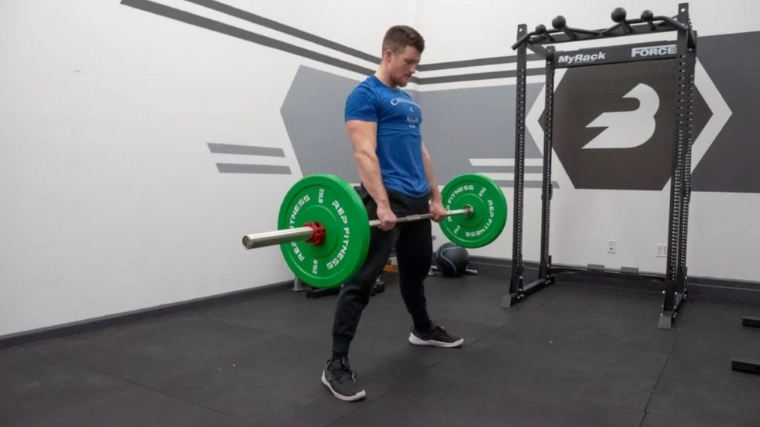The sumo is the dark horse of deadlifting. The first time you saw someone split their legs in the gym and yank a bar-bending amount of weight, you were probably more than a little puzzled. It may have even made you wonder if you’d been approaching your deadlift workouts the wrong way all along. The question, then, is just how to go about getting it right. There are many more moving parts to a good sumo than you might think. This is your crash course on the sumo deadlift, and why it’s more than worth your time.
How To Do the Sumo Deadlift

- Set Up: Assume a very wide stance with your toes pointed outward. Generally speaking, the longer your legs are, the greater your toes will point to the sides. Your shins should be perpendicular to the floor when you grab the barbell, your chest should be up, and your back flat.
- Brace: Tighten your core, back, legs, and butt to create a feeling of full-body tension. Slightly pull up on the bar and press your legs through the floor to engage your quads. Once you have found your tension, take a full breath into your belly.
- Drive: Break the barbell off the floor by pushing down with your legs. The beginning of the sumo deadlift is all about your quads — don’t pick up your hips prematurely in an attempt to move the weight.
- Lock Out: After the barbell passes your knees, aggressively thrust your hips forward. Your knees and hips should extend simultaneously to lock the bar as you reach a standing position. Your back should remain tight, with your arms hanging down low.
Sumo Deadlift Variations
You can tweak and tailor the sumo deadlift to make sure it suits your training needs better. While it isn’t the most customizable movement out there, there are ways to make it work better for you.
Deficit Sumo Deadlift
[Read More: Sumo Deficit Deadlift Benefits]
- Place a pair of weight plates on the floor a few feet apart to stand on.
- Stand on the plates with your sumo stance, then sink down to grab the bar by dropping your hips and pushing your knees out to the side.
- Grab ahold of the bar, flatten your back, and take a breath into your belly.
- Push against the plates with your feet to lift the bar and drive up until you extend your hips.
Deficit sumo deadlifts are a variation that challenges the deepest ranges of motion in the movement. In doing so, you can increase pulling strength off the floor and target the glutes and hamstrings to a greater degree.
Sumo Deadlift with Accommodating Resistance
- You’ll need resistance bands or chains for this exercise.
- Once you have bands laid across the bar (or chains hooked to the ends), set up as you would for a regular sumo deadlift.
- Break the bar off the floor and pull to a standing position, increasing your speed as you stand.
Accommodating resistance is a great way to attack weaknesses or sticking points in your technique. Since the sumo deadlift is so fickle, you might find adding bands or chains to be highly useful for increasing your lockout strength if you’re lacking in that area.
Sumo Deadlift High Pull

[Read More: Sumo Deadlift High Pull Benefits]
- Set up for a sumo deadlift with a lightly-loaded barbell.
- Get into your starting position, brace your core, and prepare to pull.
- Pull the bar off the floor. As it passes your knees, accelerate your speed.
- As you come to lockout, allow the momentum to elevate the bar and then pull it upward toward your chest by raising your elbows high.
If you practice CrossFit, the sumo deadlift high pull — sometimes abbreviated as the SDHP — has surely made its way into one or two of your daily workouts. However, instead of simply standing with the barbell, you must implement some explosive force and drive it up to shoulder height with the power of your hips and the strength of your upper back.
Sumo Deadlift Alternatives
If you’ve been doing the sumo deadlift for a while or want to alternate it with a similar deadlift variation, then here are three sumo deadlift alternatives that you might find suitable replacements.
Cossack Squat

- Stand with a wide sumo stance while holding a weight at chest-level or down in front of you.
- Break one knee and squat sideways, thinking of your non-working leg as a kickstand only for balance.
- Sit down and back into your working hip as far as you comfortably can. Then, push back to the middle and squat into the opposite leg.
Cossack squats are a great lower-body exercise, but they also closely mimic the position of your legs for the sumo deadlift. This makes them a suitable low-weight alternative if you don’t want to do heavy deadlifts.
Cable Pull-Through

- Stand facing away from an adjustable cable pulley that has been set to knee height or lower with a rope attachment fixed.
- Reach between your legs, grab the rope, and take another step forward to pull the cable taut.
- Let your arms hang down loosely while your hands clasp the ends of the rope.
- Break at the hips, pushing your butt behind you until your torso is roughly parallel to the floor. Maintain a flat back the entire time.
- Contract your glutes and hamstrings to push your hips forward and return to a standing position.
The cable pull-through is a great exercise for training the hip hinge movement pattern. If you use a wide stance, you can also closely mimic the posture of the sumo deadlift.
Who Should Do the Sumo Deadlift
It may sound (and look) appealing at a glance, but no movement is right for every athlete in every situation. If you’re on the fence about the sumo deadlift, consider whether or not you fall into one of the following categories before you take the plunge.
Powerlifters
The sport of powerlifting has one (and only one) objective — lift the most weight possible in accordance with the criteria set forth by whatever federation you compete in. With that in mind, you should use whatever technique helps you reach that goal.

[Read More: Should You Sumo Or Conventional Deadlift?]
There’s a reason the sumo deadlift is so common at powerlifting meets, after all. If you find that the sumo pull comes easy to you, and you want to be a powerlifter, there’s no reason to look elsewhere.
CrossFitters
Even though you probably won’t see it in your workouts on a weekly basis, if you train CrossFit you can stand to benefit from the occasional sumo deadlift workout. Not only will it help refine your technique on movements like the sumo deadlift high pull, there’s no shame in packing in some bonus posterior chain work to keep you strong from head to toe.
General Gymgoers
You don’t need competitive aspirations or a CrossFit class to pull sumo. If you go to the gym just to stay in shape and have fun, and the sumo deadlift looks fun, go for it. The movement provides ample stimulation to your legs and back and, perhaps most importantly, provides you with a skill to practice so your workouts are about more than just moving weight.
Sumo Deadlift Sets and Reps
Much like any other deadlift variation you perform, your sets and reps prescriptions will strongly affect the results you glean from the movement. If you’re trying to grow your legs, you wouldn’t necessarily follow the same programming as a powerlifter prepping for their next big competition.
[Read More: Your Definitive Guide to the Sumo vs Conventional Deadlift]
It’s also worth noting that the intricate setup of the sumo deadlift may make it more difficult to work with higher reps. After all, getting your technique right takes mental fortitude in its own way.
- To Practice Technique: 4-6 sets of 2-4 reps with a light weight.
- To Gain Strength: 3-5 sets of 3-5 reps with a challenging weight that allows you to maintain good form.
- For Gaining Muscle: 2-4 sets of 5-8 reps with a moderate weight.
Benefits of the Sumo Deadlift
Below are three benefits of the sumo deadlift that you should be aware of before choosing to implement it into your workout routine.
More Comfortable Mechanics (for Some)
Where the sumo deadlift shines is in its applicability to your body type. The wider stance and narrower arm position shortens the range of motion, which is why most people can lift a bit more weight compared to their standard deadlift.
Some lifters, specifically in the powerlifting community, think that the sumo deadlift is cheating. It’s not, and if a lifter is on the shorter side with shorter arms, then the sumo deadlift may not be the best variation for them.
More Lockout Strength
The sumo deadlift can be done in various ways — using bands, manipulating lifting tempo, adding chains. Because the sumo deadlift usually allows for a heavier load to be lifted, this allows you to overload your muscles with more weight than they’re used to handling.

[Read More: How to Improve Your Deadlift Lockout]
Once you switch back to conventional or trap bar deadlifts (if you don’t want to stick with sumo full-time), this newfound strength should help you complete the top part of the lift more efficiently.
Less Lower Back Strain
The setup of the sumo deadlift should reduce some of the stress placed on your lower back, provided you keep your intensity consistent. That said, it also allows you to lift heavier — a boon which may offset the reduction in spinal pressure. By default, though, if you want to limit lower back stress while still pulling from the floor, the sumo deadlift is a safe bet.
More Leg Strength
Plain and simple, the sumo deadlift demands more of your quads than the conventional pull. If you’re a leg-dominant lifter, or just want to bring up your quad strength by deadlifting, you can prioritize the sumo pull and kill two birds with one stone.
Muscles Worked by the Sumo Deadlift
Below are the primary muscle groups worked by the sumo deadlift. Like other deadlift variations, the sumo deadlift works the glutes, hamstrings, and back. However, there are some clear distinctions that you should be aware of.
Glutes
The glutes are targeted to a high degree by the sumo deadlift, as the feet are set wider and turned outwards. The hip is placed in external rotation, which in turn involves the glute medium to a higher degree.
Hamstrings
Though the conventional and Romanian deadlift recruits them more aggressively, the hamstrings are still primary movers for the sumo deadlift. That said, if you’re looking to target the hamstrings more exclusively, they may want to perform Romanian deadlifts instead.
Quadriceps
The setup of the sumo deadlift necessitates a lot of quad strength to get the lift going. If your quads lack the gusto to break the bar off the ground, you’re likely to compensate by changing your torso angle or make some other unwanted adjustment. As such, the quads play a key factor in ensuring the lift starts off on the right foot.
Lower Back
The lower back muscles, also known as the erectors, work to keep your spine stable during the pulling phase of the lift. In doing so, the spinal erectors can be developed, which is a good thing since they’re often one of the key limiting factors for a heavy deadlift.
Unlike the conventional and Romanian deadlifts, the sumo deadlift stresses your lumbar spine to a lesser degree as your torso in Romanian deadlifts is more vertical, allowing your legs to pick up much of the proverbial slack.
Common Sumo Deadlift Mistakes
As an alternative to the standard deadlift, the sumo pull comes with its own technique. The lift demands more of your hip flexibility and isn’t as customizable as other pulling movements might be, meaning that you have plenty of room to make mistakes. Here are some of the most common errors that befall sumo deadlifters.
Not Stretching
A world-class sumo deadlift requires extremely mobile hips. Much of your leverage in the sumo pull comes from the setup itself — if you can’t externally rotate your thighs, your hips won’t be in an optimal position to pull. Trying to do the sumo deadlift with rigid hips simply isn’t productive. If you’re going to take the time to pull sumo, make sure you get limber.
Hips Rising Early
Where the conventional deadlift is often fast off the floor and harder at lockout, you might find the opposite to be true in the sumo pull. The extreme posture can make it difficult to break inertia and get the bar moving at the start. To compensate, many athletes shoot their hips up in an attempt to lift with their backs.

This defeats the purpose of pulling sumo. If you find the bar fighting you in the beginning, be patient with it and continue to drive with your legs. It will move.
Rushing the Setup
Anyone can grip-and-rip a conventional deadlift to at least some degree of success. However, that kind of cavalier attitude simply will not cut it when you go to test your strength in the sumo pull. Everything from your foot angle to your torso brace to how you physically get your hands on the bar requires attention and practice.
The sumo pull gives you a tremendous amount of leverage, but only if you set yourself up for success to begin with. Take your time when setting up to ensure your technique is just right.
Frequently Asked Questions
Should I do sumo deadlifts?
It depends. If you’re new to deadlifting, you may find the exercise more comfortable compared to a conventional deadlift, since the form is a bit trickier to nail down at first. That said, you’ll only figure it out by trying out different deadlifts. If you find that conventional or trap bar deadlifts feel great, then do those.
Can I alternate between sumo and conventional deadlifts?
Sure. Doing sumo deadlifts may even help your conventional deadlift (and visa-versa). That said, if you’re a competitive powerlifter or a person focused on getting strong, you may want to stick with one variation for a few training cycles. That’s because both lifts require mechanical proficiency, and you’ll only gain that by doing it over and over and over. Simply put: practice makes perfect.
Is doing sumo deadlifts cheating?
No. You may see powerlifters comment that sumo deadlifts don’t count, but they’re either just trolling other competitors or, if they’re serious, are uninformed. Yes, for most people, sumo deadlifts create a slight leverage advantage, which is why most folks are stronger with the sumo deadlift. That doesn’t mean however that a 500-pound sumo deadlift doesn’t count. It does.